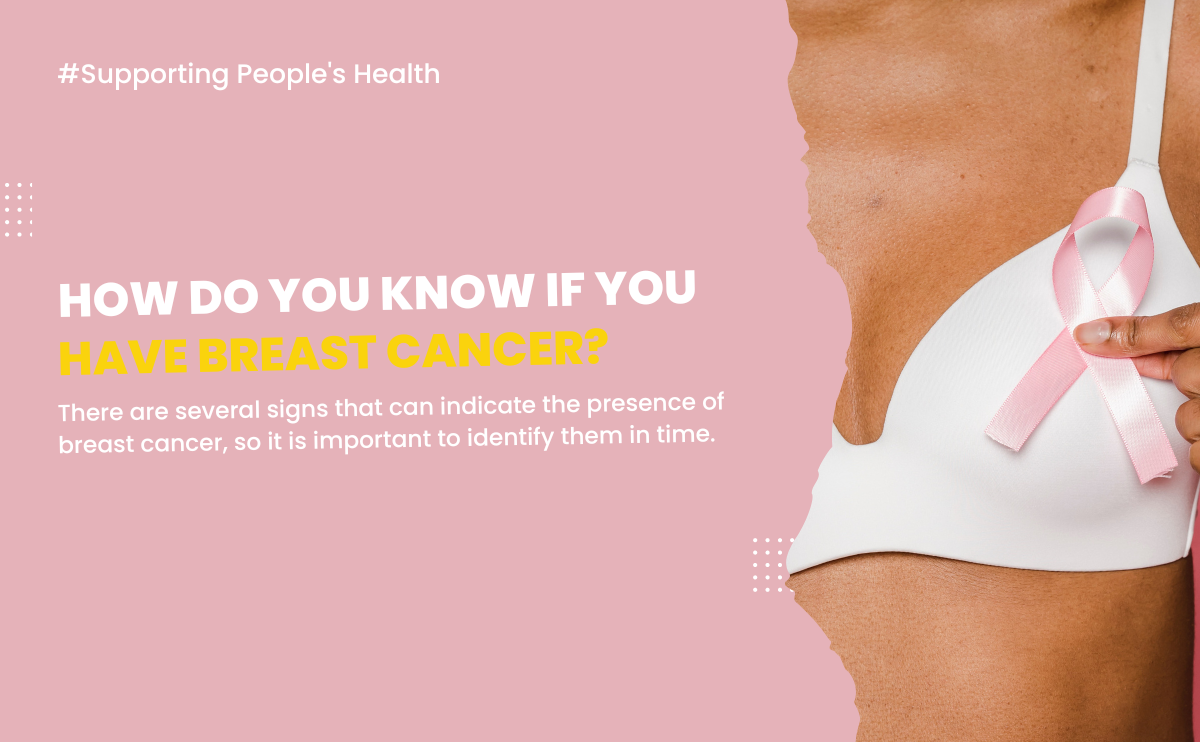How do you know if you have breast cancer?
There are several signs that can indicate the presence of breast cancer, so it is important to identify them in time. If diagnosed in the early stages, breast cancer can be treated, and the chances of survival are high. Learn about the most common symptoms of breast cancer and the main methods of treatment.
What are the types of breast cancer?
Breast cancer occurs when abnormal cells develop in the breast. They begin to divide uncontrollably and eventually transform into a cancerous tumor. Breast cancer primarily affects women, but it can also develop in men. The disease starts in the breast tissue, most commonly in the cells that line the milk ducts of the breast or in lobules.
A breast is composed of three main parts:
Lobules (glands that produce milk)
Ducts (tubes that transport milk to the nipple)
Connective tissue (made up of fibrous and fatty tissue that surrounds the lobules and ducts).
Breast cancer can spread outside the breast through blood vessels and lymphatic vessels, forming metastases.
There are several types of breast cancer, but the most common ones are:
Invasive ductal carcinoma. In this case, cancer cells grow outside the ducts, in other parts of the breast tissue. They can spread to other parts of the body.
Invasive lobular carcinoma. Abnormal cells spread from the lobules to nearby breast tissue. They can spread to other parts of the body.
Other less common forms of breast cancer include:
Ductal or lobular carcinoma in situ. This means that some of the cells lining the breast ducts or lobules have begun to become abnormal.
Paget’s disease. This is a rare skin condition of the nipple that is associated with some types of breast cancer.
Inflammatory breast cancer. This is a rare type of breast cancer. In this case, the breast may be inflamed, red, and warm.
Breast cancer in men. Although less common, men can also develop breast cancer.
Why does breast cancer occur?
There are certain risk factors that can predispose to the disease. However, there are some people who, despite having multiple risk factors, do not develop breast cancer.
Risk factors that can cause breast cancer are:
A personal history of invasive breast cancer (ductal carcinoma in situ or lobular carcinoma in situ) or benign breast disease (non-cancerous).
A family history of breast cancer. Your doctor will ask if there have been cases of cancer in your family (your mother, daughter, or sister).
Inherited genetic changes. The BRCA1 or BRCA2 genes increase the risk of breast cancer.
Exposure of breast tissue to estrogen produced by the body. This can be caused by menstruation at a young age, advanced age at first birth, or late onset of menopause.
Hormone therapy. Especially estrogen combined with progestin for menopausal symptoms can predispose to breast cancer.
Radiation therapy to the breast
Alcohol consumption. Even consuming a small amount of alcohol can increase the risk of breast cancer.
Obesity. Sedentary lifestyle, excessive weight, and an unhealthy diet are some of the greatest risk factors for breast cancer.
Birth control pills. There are studies that show that taking birth control pills increases the risk of breast cancer. However, the risk is small and decreases when the woman stops taking such pills.
Age. People over the age of 40 are at increased risk of developing the disease.
The most common symptoms of breast cancer
The level of the breast or armpit can be another common sign of breast cancer. Other frequent signs may include:
- Change in breast size and shape
- Skin changes in the breast area, such as puckering, dimpling, rash or redness
- Nipple discharge from a woman who is not pregnant or breastfeeding
- Changes in nipple position or shape
- Breast lumps
- Most breast lumps are benign, meaning they are not cancer. They can be:
- Cysts (fluid-filled sacs in breast tissue). Cysts are quite common and are not cancerous.
- Fibroadenomas (fibrous glandular tissue). These are common in women under 30.
- Normal breast changes that occur at certain times.
It is important for the doctor to always check lumps. They will recommend certain tests to find out whether they are cancerous or not.
- Swelling in the armpit area
- These may be inflamed lymph nodes when there is an infection or cold in the body. A less common cause of lymph node or armpit lumps is breast cancer that has spread to that area.
- Change in breast size and shape
- Usually, breasts may become swollen before the menstrual cycle. Additionally, these symptoms may occur in pregnant women, so not all breast size changes can be cancer.
- Skin changes around the nipple or other parts of the breast
- These may be symptoms of other breast conditions. However, if there are nipple discharges in women who are not pregnant, urgent medical consultation is recommended. Additionally, unusual nipple changes may be signs of breast cancer.
- Symptoms of rare types of breast cancer
- Symptoms of inflammatory breast cancer may be different from other types of breast cancer. In this case, the entire breast may appear red and inflamed and is painful. In addition, the breast may feel heavy, and the skin may look like orange peel.
- Paget’s disease is a rare skin condition and sometimes a symptom of underlying breast cancer. Symptoms are a red, scaly rash on the nipple and surrounding area. It can cause itching and looks like eczema.
In the case of breast cancer in men, the most common symptoms are:
- A breast lump
- Redness, irritation, or scaling skin on the breast
- Nipple discharge
- Retraction of the nipple or pain in the nipple area
Screening tests before symptoms appear
Breast cancer screening tests involve checking a woman’s breasts before signs or symptoms of the disease are present. Although breast cancer screening cannot prevent the disease, it can help detect breast cancer early. Diagnosing cancer in the early stages is crucial because it can be treated more easily.
Here are the main screening methods for breast cancer:
- Mammogram. This is actually an X-ray of the breast. For many women, mammograms are the best way to identify early cases of cancer. Regular mammography reduces the risk of dying from breast cancer. Experts recommend that women aged 50-74, with average risk of breast cancer, have a mammogram every two years. Women over 40 should discuss with their doctor when to start having a mammogram.
- MRI. This procedure uses magnets and radio waves to take pictures of the breast. Usually, MRI is used in conjunction with mammography to examine women at high risk for breast cancer.
- Physical exam. With this method, the doctor can identify the presence of a lump or any other abnormal changes in the breast.
Additionally, breastfeeding may play an important role in preventing breast cancer. The longer a woman breastfeeds, the stronger the protective effect. Also, limiting postmenopausal hormone therapy can be helpful in reducing the risk of breast cancer.
In conclusion, it is extremely important to pay attention to any signs that could indicate the presence of breast cancer. Visit your doctor for regular check-ups and undergo screening tests to reduce any risk of cancerous cells developing.
The earlier breast cancer is detected and treatment starts, the higher the chances of cure.



